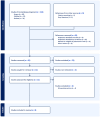AI-accelerated prostate MRI: a systematic review
- PMID: 38718224
- PMCID: PMC11186563
- DOI: 10.1093/bjr/tqae093
AI-accelerated prostate MRI: a systematic review
Abstract
Background: Prostate cancer ranks among the most prevalent cancers affecting men globally. While conventional MRI serves as a diagnostic tool, its extended acquisition time, associated costs, and strain on healthcare systems, underscore the necessity for more efficient methods. The emergence of AI-acceleration in prostate MRI offers promise to mitigate these challenges.
Methods: A systematic review of studies looking at AI-accelerated prostate MRI was conducted, with a focus on acquisition time along with various qualitative and quantitative measurements.
Results: Two primary findings were observed. Firstly, all studies indicated that AI-acceleration in MRI achieved notable reductions in acquisition times without compromising image quality. This efficiency offers potential clinical advantages, including reduced scan durations, improved scheduling, diminished patient discomfort, and economic benefits. Secondly, AI demonstrated a beneficial effect in reducing or maintaining artefact levels in T2-weighted images despite this accelerated acquisition time. Inconsistent results were found in all other domains, which were likely influenced by factors such as heterogeneity in methodologies, variability in AI models, and diverse radiologist profiles. These variances underscore the need for larger, more robust studies, standardization, and diverse training datasets for AI models.
Conclusion: The integration of AI-acceleration in prostate MRI thus far shows some promising results for efficient and enhanced scanning. These advancements may fill current gaps in early detection and prognosis. However, careful navigation and collaborative efforts are essential to overcome challenges and maximize the potential of this innovative and evolving field.
Advances in knowledge: This article reveals overall significant reductions in acquisition time without compromised image quality in AI-accelerated prostate MRI, highlighting potential clinical and diagnostic advantages.
Keywords: AI-accelerated imaging; MRI; artificial intelligence; prostate cancer.
© The Author(s) 2024. Published by Oxford University Press on behalf of the British Institute of Radiology. All rights reserved. For permissions, please email: journals.permissions@oup.com.
Conflict of interest statement
The authors declare no conflicts of interest.
References
Publication types
MeSH terms
LinkOut - more resources
Full Text Sources
Medical


